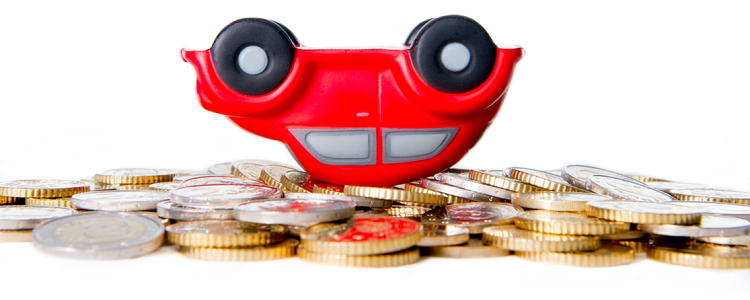These days, it seems like things lose their value more quickly than ever, especially expensive ones like cars. When you need to trade in your vehicle but have high negative equity, you may feel like you're up against a brick wall. Fear not! This situation is more common than you might think, and there's more than one way to get out of an auto loan with high negative equity.
Having Negative Equity Is Common
 Negative equity – also known as being upside down or underwater – happens when you owe more on your car loan than the vehicle is worth. This happens most often at the beginning of an auto loan, especially if you're financing a brand-new car. On average, new vehicles lose around 20% of their value in the first year of ownership.
Negative equity – also known as being upside down or underwater – happens when you owe more on your car loan than the vehicle is worth. This happens most often at the beginning of an auto loan, especially if you're financing a brand-new car. On average, new vehicles lose around 20% of their value in the first year of ownership.
If you start off with high negative equity, it can sometimes be difficult to close the gap between the value of the car and the loan balance by the time you're ready to trade in your vehicle. For this reason, it's common for many lenders to allow you to "roll over" your negative equity into your next loan.
Rolling over your negative equity simply means a lender lets you get another car now, while they add the remaining balance of your existing loan (which they pay off) to the new loan. This makes your new loan more expensive, which means you're paying more in interest charges, and possibly seeing a higher monthly payment amount, even if you stretch your loan term out (which isn't recommended with bad credit).
Not all lenders are willing to roll over someone's negative equity, but plenty do. Even though you may be able to accomplish a trade in with high negative equity, it's not the most affordable, or wisest, option, especially if you have bad credit.
Determining Your Equity Amount
Before we discuss the alternatives to rolling over your negative equity, you should make sure that you know the current estimated value of your vehicle, and how much you owe your lender. The less negative equity you have, the better off you are.
In order to see how much negative equity you have, you should first contact your lender, or sign in to your auto loan account, and get a 10-day payoff quote. This amount gives you the remaining balance on your loan with 10 days of interest included. Next, get an estimated value of your car by visiting an online valuation site such as Kelley Blue Book or NADAguides.
These sites give you an estimate of value based on information you enter, so be honest in your answers. If you underestimate the mileage or damages to your vehicle, the dealer may give you a much lower offer than the estimate.
Dealing With High Negative Equity
If you find out that you do have a high amount of negative equity, a smart option is to reduce the amount of negative equity in your car before you trade in your vehicle.
Each payment you make can put you closer to an equity position. To really gain momentum, you should make the biggest payments you can, as often as you can. Most auto loans today are simple interest loans, which typically means there's no penalty for early loan repayment, but read over your contract details to be sure.
When making extra payments isn't an option, you could opt to pay off the difference between your car's actual cash value and the amount you owe. When you go this route, you're still trading in your vehicle to a new lender, but they're only going to pay your current lender the car's value, and you're responsible for paying the rest. This doesn't help you out in any way financially, but it allows you to get out of your current loan.
If another vehicle isn't a dire emergency, waiting it out is always an option, since each payment automatically reduces the amount of negative equity your car is carrying. When you've made enough payment to break even, or have equity in the vehicle, then you can think about trading it in.
If Rollover Is Your Only Option
Trading in a car with high negative equity may be your only option if you need another vehicle right now and can't wait to gain an equity position. Since rolling over your negative equity is going to increase your new loan balance, we have a few tips for getting off the trade-in treadmill before you find yourself stuck with more negative equity than you can handle.
If you're rolling over a negative equity auto loan be sure to:
- Make the biggest down payment you can – This way, you're borrowing less and there's less money to be charged interest on, which saves you money over the term of your loan.
- Take out the shortest loan term possible – If you find yourself stretching your loan term to seven or eight years just to get an affordable payment, you may want to reconsider. The longer you take to pay off a loan, the more it costs you in the long run.
- Opt for an affordable car – If you can comfortably afford your auto loan, that's good! Don't fall into the trap of getting a more expensive vehicle just because you can. If there's no reason to upgrade you should wait, as it isn't the time to get your dream car if you have poor credit.
- Choose a vehicle that holds its value – Different cars depreciate at different rates. Certain makes and models are known for hanging onto their value longer than others, which can give you a better chance at closing the equity gap.
Ready to Trade In to Your Next Auto Loan?
Now that you know it's both possible and common to roll over the high negative equity on your car loan when you're looking for a vehicle, it's time to find a place to take your trade-in.
When you're struggling with credit challenges, you need to be sure to work with the right type of lender that can help you. Working with a subprime lender through a special finance dealership can often be a good option for people who need a bad credit auto loan, and Auto Credit Express can help you find one near you.
We've cultivated a network of dealers around the country that are signed up with the lenders you're looking for. To get started, fill out our free and easy car loan request form. After you do, we'll get to work finding a local dealership for you to trade in your car!















